

 | Phyton-International Journal of Experimental Botany |  |
DOI: 10.32604/phyton.2022.021137
ARTICLE
Organic Amendments Improve Plant Morpho-Physiology and Antioxidant Metabolism in Mitigating Drought Stress in Bread Wheat (Triticum aestivum L.)
1Department of Agronomy, Faculty of Agriculture, Sher-e-Bangla Agricultural University, Dhaka, 1207, Bangladesh
2Department of Biology, College of Science, Taif University, Taif, 21944, Saudi Arabia
*Corresponding Author: Mirza Hasanuzzaman. Email: mhzsauag@yahoo.com
#These authors contributed equally to this work
Received: 29 December 2021; Accepted: 11 March 2022
Abstract: Due to the unpredictable climate change, drought stress is being considered as one of the major threats to crop production. Wheat (Triticum aestivum L. cv. BARI Gom-26) being a dry season crop frequently faces scarcity of water and results in a lower yield. Therefore, this experiment aims to explore the role of different organic amendments (OAs) in mitigating drought stress-induced damage. The pot experiment consisted of different organic amendments viz. compost, vermicompost and poultry manure @0.09 kg m−2 soil, biochar @2.5% w/w soil and chitosan @1% w/w soil which was imposed on the plants grown under both well-watered and drought conditions. Results showed that drought stress reduced plant height (15%), SPAD value (16%), relative water content (13%), number of spikelet spike−1 (17%), number of grains spike−1 (12%), and 100-grain weight (18%). Organic amendments act as a protectant and reduce drought stress-induced damages by enhancing the morpho-physiological and yield attributes. Vermicompost enhanced SPAD value by 18%, number of spikelets spike−1 by 20%, number of grains spike−1 by 17%, whereas poultry manure increased plant height by 16% under drought condition compared to control plant. Unlike other OAs applied, vermicompost was proved to be capable of reducing the higher lipid peroxidation and proline content raised by drought condition. Drought stress-induced increment of catalase, ascorbate peroxidase and glutathione reductase activities were also efficiently modulated by the organic amendment application. The present study concluded that OAs play significant roles in alleviating drought stress-induced damages by improving the morpho-physiological attributes and among the different types of OAs used vermicompost performed better which in addition ceased the production of reactive oxygen species.
Keywords: Antioxidant defense; biochar; cereal crop; chitosan; compost; poultry manure; reactive oxygen species; vermicompost
The unpredictable nature of climate has been creating a lot of confusion and adverse situations for the living beings on earth. Environmental constraints are something that completely ceases lives and livings. Different types of abiotic stress are the prime concern for environmentalists and researchers worldwide. Drought or lack of available water for proper plant growth is considered as one of the most devastating abiotic stresses. A significant number of areas in the earth are still prone to drought and hence limit crop production [1]. The multiple injurious effects of drought stress have turned it into one of the most devastating abiotic stresses. Starting with osmotic imbalance as the primary effect, drought stress evolves multiple physiological and metabolic malfunctions in plants such as reduction of photosynthesis, transpiration, electron transport rate, stomatal conductance, water use efficiency and impairment of cellular organelles. Thus, drought stress ultimately results in disrupted growth and development, or yield reduction. In addition, most of the above-mentioned effects of drought lead to the overproduction of reactive oxygen species (ROS; e.g., O2•−, H2O2, 1O2 and OH•, etc.) that are also responsible for oxidative or cellular damages [2].
Wheat (Triticum aestivum L.) is globally one of the most important cultivated cereal crops [3]. One-third of the global population consumes wheat and to meet the required demand of the growing population by 2050, wheat production needs to be increased by 50% [1]. One of the major concerns for wheat production is different types of environmental stresses including drought. Hence, focus should be given on the in-depth studies of drought-induced changes in wheat and possible mitigation approaches to develop drought tolerance ensuring expected yield. To tolerate the destructive effects caused by abiotic stresses, plants possess some intrinsic mechanisms like antioxidant defense system. By means of a number of antioxidant enzymes (superoxide dismutase, SOD; catalase, CAT; ascorbate peroxidase, APX; glutathione reductase, GR; monodehydroascorbate reductase, MDHAR; dehydroascorbate reductase, DHAR; glutathione peroxidase, GPX; and glutathione S-transferase, GST) and non-enzymatic antioxidants (ascorbic acid, AsA; glutathione, GSH; phenolic compounds, alkaloids, non-protein amino acids and tocopherols) this defense system efficiently scavenges the toxic ROS [4]. Use of different protectants, alterations of agronomic managements or supplementation with different beneficial elements are some of the mitigative ways of abiotic stress like drought.
The application of organic amendments (OAs) improves soil structure and increases nutrient availability and thus helps in the betterment of soil productivity and fertility [5]. These positive impacts of different OAs facilitate plants with a strong innate system to tolerate different adverse situations or efficiently prevent the stress injury. Compost, vermicompost, poultry manure, biochar, chitosan etc. are some of the common OAs used worldwide. Compost is organic matter produced from the decomposition of living matters and it can improve different physico-chemical and biological properties of soil like water holding capacity, microbial activities, etc. [6]. Vermicompost is another type of compost in which earthworms are used for the facilitation of decomposition and has similar beneficial effects on soil and plant like compost [5]. Another important organic amendment is poultry manure that is rich in N compounds like uric acid and undigested protein [7]. Besides boosting up soil properties, poultry manure enhances cation exchange capacity and augments the process of humification with ignorable toxic pathogens or materials which makes it suitable to use under drought condition to ensure better yield [7]. Currently, biochar is gaining attention globally because of the carbon sequestration ability and to reduce contamination of surface and groundwater [6]. Biochar is capable of mitigating the adverse effects of drought and can ensure growth and yield of wheat [8]. Chitosan, derived by N-deacetylation of chitin and crustacean shells, is also a popular type of organic amendment because of its wide array of properties such as antimicrobial, antihypertensive and antioxidant. In addition, it has been proven effective against drought stress in wheat [9]. It can be summarized that the above-discussed types of organic manures are all beneficial to plants regarding either production or tolerance to adversities.
To date, very few literatures are available on the effects of different OAs in mitigating drought stress-induced negative effects on wheat and hence our experiment was based on this hypothesis that OAs supplementation plays a versatile role in improving plant morphophysiological and antioxidant properties and so can induce plant tolerance to drought.
2.1 Plant Material and Treatments
Uniform and healthy seeds of wheat (Triticum aestivum L. cv. BARI Gom-26) were sown in 14 L plastic pots. The recommended doses of fertilizers were mixed with soil during pot preparation (Table S1). Besides, OAs were used as treatment as follows: control (no OA), compost, vermicompost and poultry manure @0.09 kg m−2 soil, biochar @2.5% w/w soil and chitosan @1% w/w soil. The nutrient composition of these OAs has been provided (Table S2). Twelve seeds were sown per pot and finally five uniform plants were allowed to grow in each pot. Up to 20 days after sowing (DAS), all pots were watered as required. After that watering was withheld in one set of treatments which were considered as drought stressed plants. The other set of pots were watered as required. The experimental design followed in this experiment was the completely randomized design (CRD) with three replications. Data collection was done at 40 DAS except for yield contributing parameters. Harvesting was done when the plants turned yellowish golden in color and yield contributing parameters were recorded then. Plant protection measures were taken when required. The whole experiment was carried out inside a net house where rainfall was controlled and the climatic data during that period have been recorded (Table S3).
2.2 Measurement of Plant Height
Plant height (cm) was recorded at 50 DAS. It was measured by using a measuring scale from ground level to highest tip of the leaf of wheat plants. The average data of five randomly selected plants from each pot was considered.
2.3 Measurement of SPAD Values
The top, middle and base of each leaf (five randomly selected leaves from each pot) were measured with the help of Soil Plant Analysis and Development (SPAD) meter (Minolta Camera Co., Osaka, Japan) and then averaged [10].
2.4 Measurement of Yield Contributing Parameters
Spike length, number of spikelet spike−1, number of grains spike−1 and 100-seed weight were measured following standard procedures.
2.5 Measurement of Relative Water Content
Leaves of five plants from each pot were randomly collected, cleaned and weighed as fresh weight (FW). The weighted samples were immediately sunk into distilled water in a Petri dish. After 24 h, excess water from surfaces were removed and turgid weight (TW) were measured. After drying the samples in oven for 72 h, dry weight (DW) was measured. The formula mentioned below was used to calculate the relative water content (RWC): RWC (%) = (FW−DW)/(TW−DW) × 100 [11].
2.6 Determination of Proline Content
For the estimation of proline (Pro), (0.5 g) leaves were homogenized in 3% sulfo-salicylic acid (5 ml) on ice. The homogenate was than centrifuged at 11,500 × g for 15 min and with 1 mL of the supernatant, 1 mL of acid ninhydrin (1.25 g ninhydrin in 30 mL glacial acetic acid and 20 mL 6 M phosphoric acid) and 1 mL of glacial acetic acid were mixed. The mixture was then boiled (100°C) for 1 h in water bath, and then transferred to test tubes to keep on ice. Two mL of toluene was then added and vortexed well to obtain the chromophore containing toluene which was read spectrophotometrically at 520 nm using only toluene as a blank solution. A standard curve was used to calculate the amount of Pro [12].
2.7 Determination of MDA Content
The protocol developed by Heath et al. [13] was followed to measure the lipid peroxidation (malondialdehyde, MDA content) with slight modification by Hasanuzzaman et al. [4]. Three ml of 5% (w/v) trichloroacetic acid (TCA) was taken to homogenize leaf sample (0.5 g) in and then centrifuged (11,500 × g for 15 min). One mL of supernatant was allowed to react with 4 mL of thiobarbituric acid reagent (0.5% of TBA in 20% TCA) by warming the mixture in water bath (95°C) for 30 min. At the completion of the warming period, those were rapidly cooled on ice and centrifuged again for 10 min. The optical density of the solution was read spectrophotometrically at both 532 nm and 600 nm; later one to rectify the non-specific absorbance by subtracting from the value at 532 nm. An extinction coefficient of 155 mM−1 cm−1 was used to calculate the MDA content expressed as nmol g−1 FW.
2.8 Measurement of Enzymatic Activity
Peroxidases (POD, 1.11.1.7) activity was measured according to Hemeda et al. [14] using the enzyme essay that is a mixture of sodium phosphate buffer (pH 6.0), methoxyphenol and 30% H2O2. The activity was observed at 470 nm.
Catalase (CAT, EC: 1.11.1.6) activity was measured following the procedure of Hasanuzzaman et al. [4] by the enzyme assay which is the mixture of 50 mM K-P buffer (pH 7.0), 15 mM H2O2 and enzyme solution. The activity was observed at 240 nm.
Ascorbate peroxidase (APX, EC: 1.11.1.11) activity was measured as Nakano et al. [15] using the enzyme assay containing 50 mM K-P buffer (pH 7.0), 0.5 mM AsA, 0.1 mM H2O2, 0.1 mM EDTA and enzyme solution. The activity was observed at 290 nm.
Glutathione reductase (GR, EC: 1.6.4.2) activity was estimated following the method of Hasanuzzaman et al. [4] with the enzyme assay containing 0.1 M K-P buffer (pH 7.0), 1 mM EDTA, 1 mM GSSG, 0.2 mM NADPH and enzyme solution. The activity was observed at 340 nm.
All data were statistically analyzed by using CoStat v.6. 400 [16] and subjected to two-way analysis of variance (ANOVA) to analyze the effect of different water regimes (WR) and OAs (Table S4). Mean (±SD) was calculated from three replicates for each treatment at P ≤ 0.05 applying the Tukey’s honestly significant difference (HSD) test.
The effects of both WR and OA applied were significant (P < 0.01) on plant height (Table S4). The interaction of these factors (WR × OA) also affected plant height significantly (P < 0.05). Under well-watered condition, the tallest plants were recorded in poultry manure treatment. The recorded data revealed that plant height increased in poultry manure, biochar and vermicompost at 34, 25 and 19%, respectively. On the other hand, increased plant height in water deficit condition was filed and highest data found in poultry manure in 16% more than untreated control whereas lowest in biochar treatment and it was 10% more than control (Fig. 1).
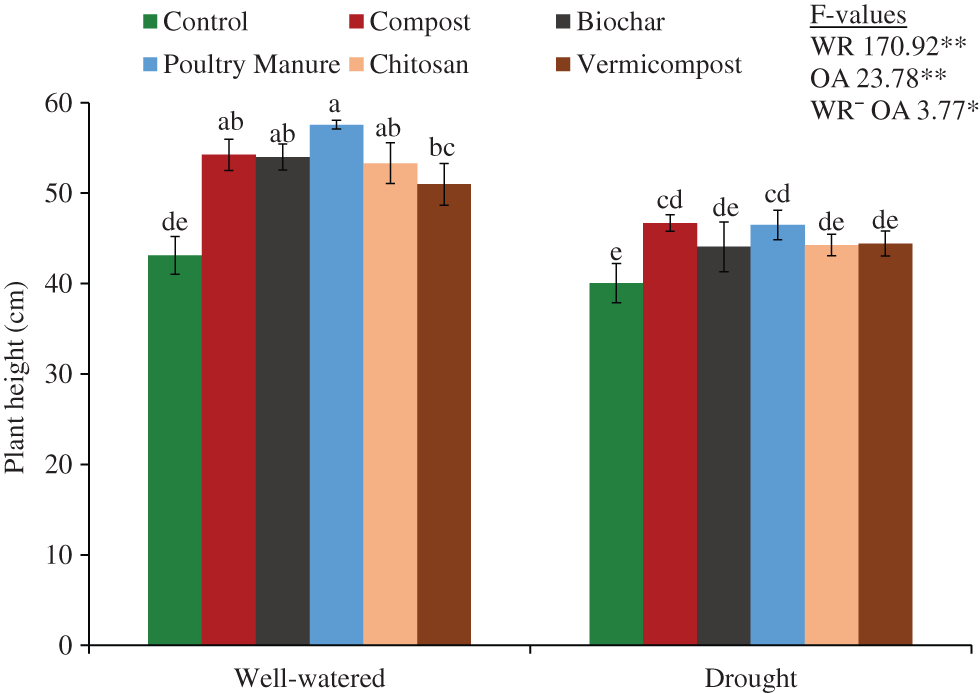
Figure 1: Effects of different organic amendments on plant height of wheat under drought stress. Mean (±SD) was calculated from three replicates for each treatment. Bars with different letters are significantly different at P < 0.05 applying the Tukey’s HSD test. **P < 0.01, *P < 0.05, ns = not significant, WR = Water regimes, OA = Organic amendments
Changes in leaf SPAD value were recorded to be significant (P < 0.01) caused by either WR or OAs. The combined effect of drought and OAs resulted in a variation of SPAD value in leaf which was not significant (Table S4). Under well-watered condition vermicompost treated plants showed the highest SPAD value and all the other treatments showed a similar result. On the other hand, SPAD value was increased under stressful condition in vermicompost and biochar by 18% and 16%, respectively and the lowest result was attained from drought treatment without any OA (Fig. 2).
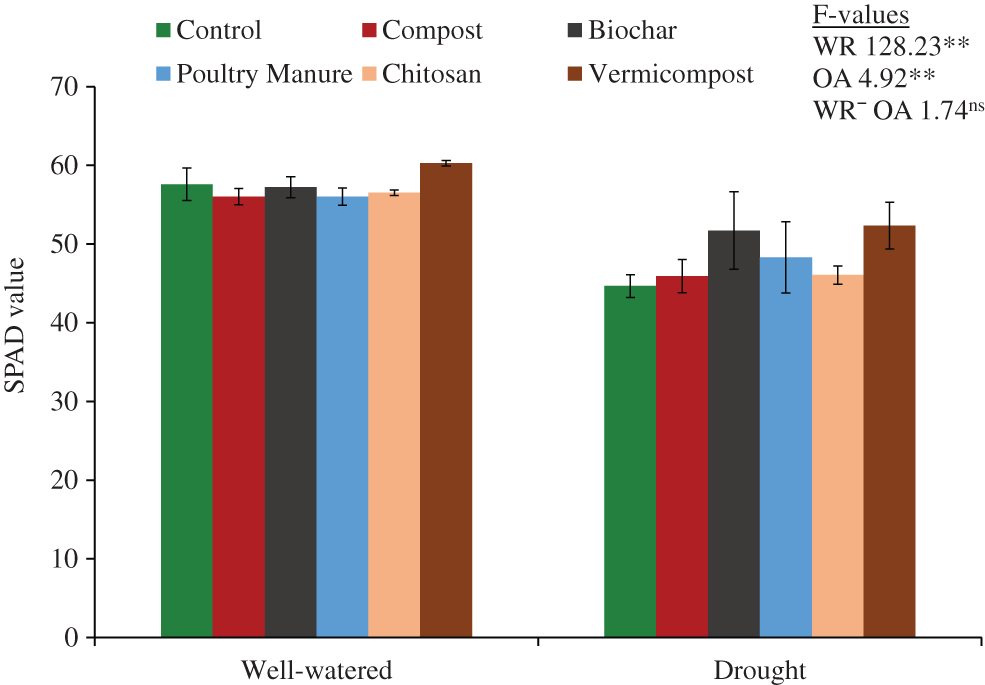
Figure 2: Effects of different organic amendments on the SPAD values of wheat leaves under drought stress. Mean (±SD) was calculated from three replicates for each treatment. **P < 0.01, *P < 0.05, ns = not significant, WR = Water regimes, OA = Organic amendments
3.3 Relative Water Content and Proline Content
Relative water content was reduced significantly (P < 0.01) by drought. Though different OAs changed the leaf RWC significantly (P < 0.05), their interactive effects were non-significant (Table S4). The highest leaf RWC was obtained from compost treatment, and compost and vermicompost attained 4% and 3%, respectively more RWC than the control condition. On the contrary, the lowest result attained from poultry manure and it was 4% less than control under well-watered condition. On the other hand, under stressful condition all treatment resulted in better RWC than control and 12% and 8%, respectively more RWC found in vermicompost and compost treatment (Fig. 3A).
Proline content was affected significantly (P < 0.01) by WR, OAs or their combined effects. Compared with well-watered control Pro content was increased markedly in water-deficit plants. In contrast, OAs supplementation in water deficit plants reduced Pro content significantly compared to well-watered control and untreated stressed plants. Compost, biochar and vermicompost showed a notable reduction of Pro content by 13, 14 and 21%, respectively over control (Fig. 3B).
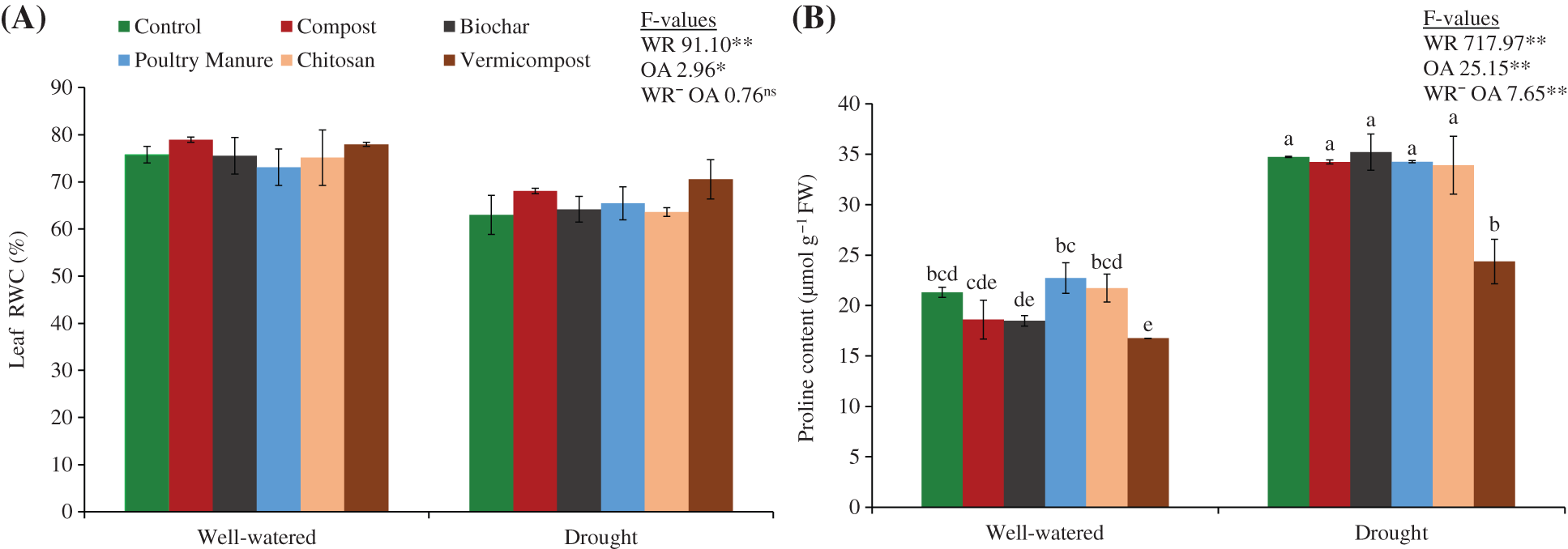
Figure 3: Effects of different organic amendments on (A) leaf RWC and (B) Pro content of wheat under drought stress. Mean (±SD) was calculated from three replicates for each treatment. Bars with different letters are significantly different at P ≤ 0.05 applying the Tukey’s HSD test. **P < 0.01, *P < 0.05, ns = not significant, WR = Water regimes, OA = Organic amendments
Malondialdehyde content was also affected significantly (P < 0.01) by WR, OAs or their combined effects. Under well-watered condition MDA content was not affected by the application of OAs, and poultry manure treated plants showed the lowest content of MDA. On the contrary, under drought condition, control plants showed the highest MDA content. If compared to the well-watered plants, MDA content was higher in all treatments under drought condition. However, when compared among the stressed plants only, OAs were capable of lowering the MDA contents efficiently except poultry manure (Fig. 4).
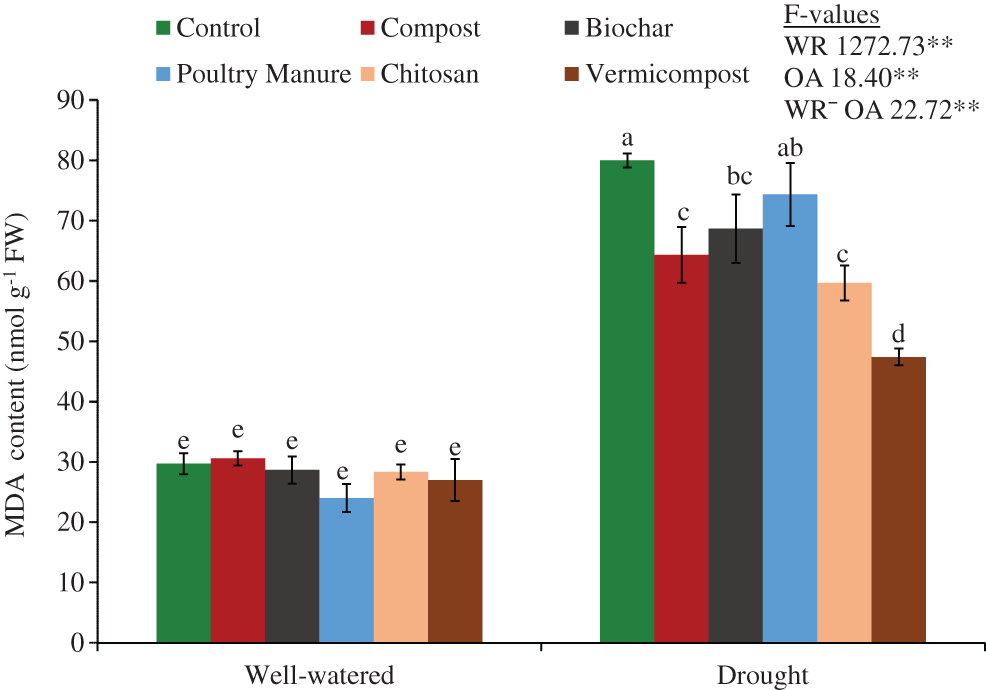
Figure 4: Effects of different organic amendments on the MDA content of wheat under drought stress. Mean (±SD) was calculated from three replicates for each treatment. Bars with different letters are significantly different at P < 0.05 applying the Tukey’s HSD test. **P < 0.01, *P < 0.05, ns = not significant, WR = Water regimes, OA = Organic amendments
3.5 Activity of Antioxidant Enzymes
Activities of all antioxidant enzymes measured significantly (P < 0.01) changed due to different WR and OAs applied. But their interaction (WR × OA) could significantly (P < 0.05) alter the activities of POD, CAT and GR; APX activity showed non-significant variations (Table S4).
The activity of antioxidant enzymes such as CAT, APX and GR showed an increment upon exposure to drought at a rate of 68, 43 and 67%, respectively. POD activity was raised compared to respective well-watered treatments except for the control and compost treatments. If considered among the different OAs under drought condition, chitosan showed the highest POD activity followed by poultry manure (Fig. 5A). The activity of CAT was recorded the highest in the drought stressed plant without any organic amendment followed by poultry manure, biochar and chitosan treatments of that (Fig. 5B). The trend of activity increment followed a regular pattern in case of APX with the highest increase in drought stressed wheat plants with no OAs (Fig. 5C). Within the well-watered plants with different OAs application, no variation was observed in GR activity, but when exposed to drought, no amendment resulted in the highest value followed by chitosan (Fig. 5D).
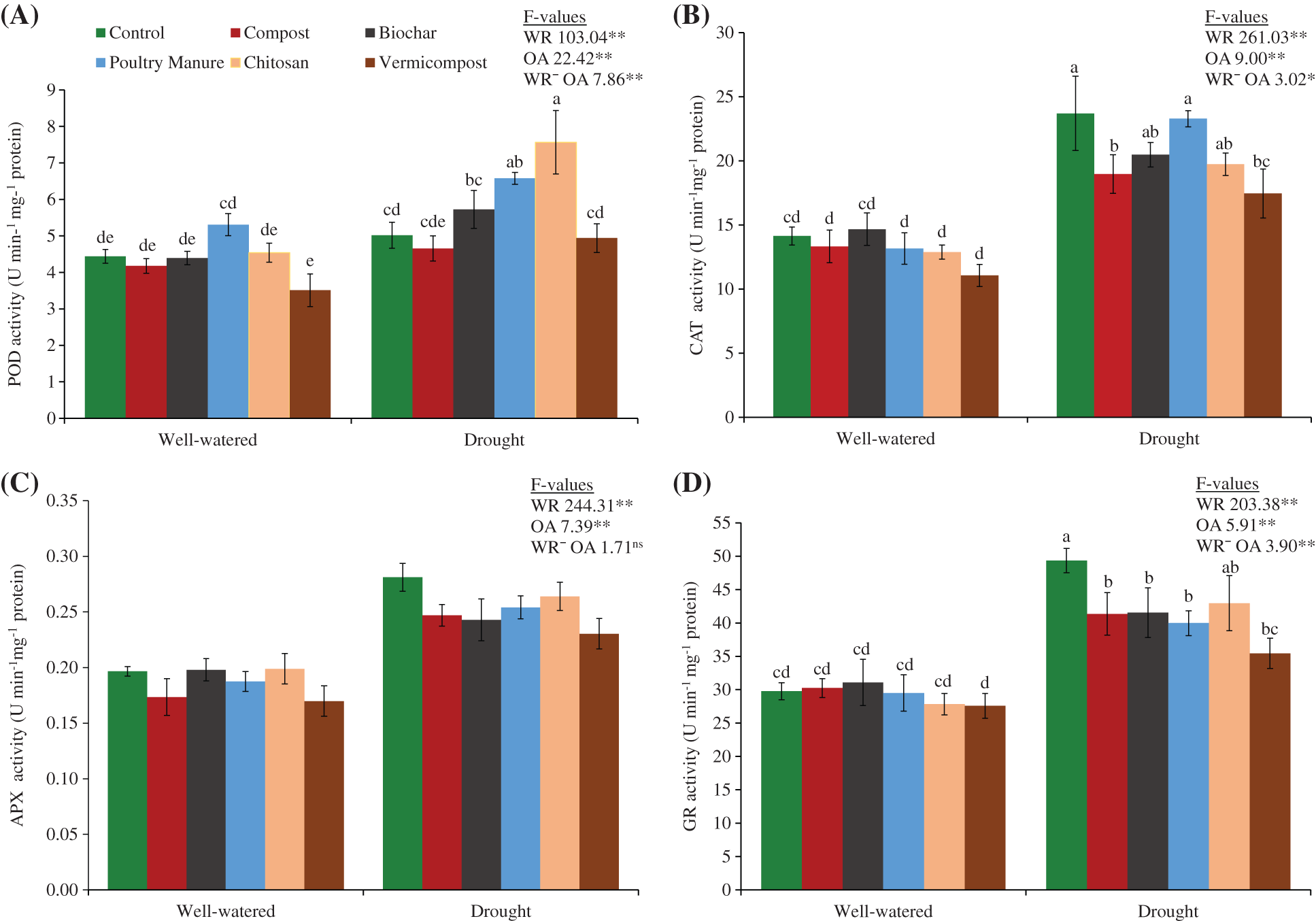
Figure 5: Effects of different organic amendments on the activities of (A) POD, (B) CAT, (C) APX and (D) GR enzymes of wheat under drought stress. Mean (±SD) was calculated from three replicates for each treatment. Bars with different letters are significantly different at P < 0.05 applying the Tukey’s HSD test. **P < 0.01, *P < 0.05, ns = not significant, WR = Water regimes, OA = Organic amendments
3.6 Yield Contributing Parameters
All yield contributing parameters were affected significantly (P < 0.05) by WR and OA. But in case of their interactive effects, number of grain spike−1 and 100-grain weight showed non-significant changes (Table S4).
The highest spike length was found in vermicompost and poultry manure treatment that was 15% and 9%, respectively more than the control condition. The lowest spike length was found in drought stress condition similar to other OAs applied. On the other hand, under water deficit condition highest value was observed in vermicompost treatment which was 13% more than control condition (Fig. 6A).
The maximum number of spikelet spike−1 was attained from vermicompost treatment. Vermicompost and poultry manure resulted in 14% and 6%, respectively more spikelet spike−1 than control and the lowest number of spikelet spike−1 was found in biochar treatment under well-watered condition which was 3% less than control. On the other hand, under water deficit condition greatest value of spikelet spike−1 was recorded in vermicompost treatment which was 20% higher than control and the lowest data recorded in control condition (Fig. 6B). Vermicompost and poultry manure showed a greater number of grains spike−1 that was 6% and 4%, respectively more than well-watered control.
A remarkable reduction of grain weight was recorded with the combined effect of drought and different OAs. The highest 100-grain weight was obtained from vermicompost treatment and it was 11% more than the control treatment, under well-watered condition. Oppositely, under water deficit condition highest result was found from vermicompost treatment and the lowest received from biochar was 4% less than control treatment (Fig. 6D).
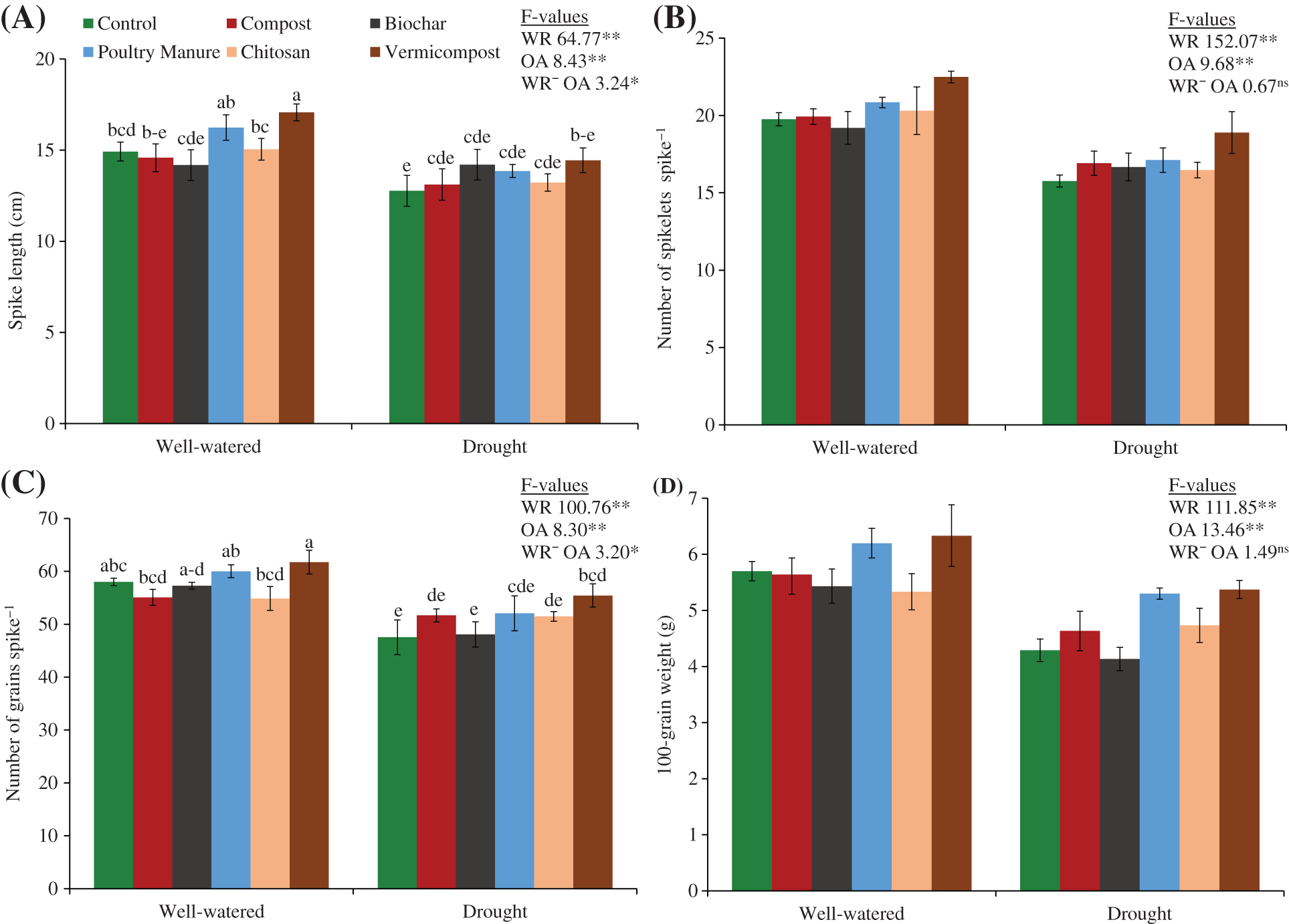
Figure 6: Effects of different organic amendments on (A) spike length, (B) number of spikelets spike−1, (C) number of grains spike−1 and (D) 100-grain weight of wheat under drought stress. Mean (±SD) was calculated from three replicates for each treatment. Bars with different letters are significantly different at P < 0.05 applying the Tukey’s HSD test. **P < 0.01, *P < 0.05, ns− not significant, WR = Water regimes, OA = Organic amendments
Drought has been well-known to cause a remarkable decline in crop productivity by hampering the morpho-physiological biochemical processes of plant. Lack of water disrupts the cell expansion and hereby membrane integrity which subsequently results in osmotic stress, stomatal closure and protein denaturation.
The findings of this experiment have revealed how different OAs can help to reduce the negative impacts of drought in wheat by maintaining plant growth and antioxidant defense system. The growth parameter, plant height was recorded to be lowest in the control treatments that are without any OAs (Fig. 1). As the plants with OAs supplementation are more likely to get a sufficient amount of nutrients and a better soil health such results are expected and have been reported earlier [6,17].
The SPAD meter can rapidly measure SPAD values as a proxy for chlorophyll (chl) content [18]. Variation in SPAD value was also recorded in this experiment where the highest reduction was observed in drought stressed plants without any OA supplementation (Fig. 2). Water deficit condition leads to metabolic dysfunctions which ultimately disrupts the function of photosynthetic pigments. Drought-induced reduction of chl due to impaired functions of chloroplast was reported in many studies so far [19−21]. However, the application of vermicompost and biochar seemed to retain the degradation of chl and induce drought tolerance to some extent. This might be because vermicompost helps in chl synthesis by providing the key minerals like N, P, K, Mg, Ca, etc. [21] and biochar facilitates with reducing the oxidative stress [20].
To assess the water status of plant RWC is measured which is a potential indicator of plant metabolic activity too. Drought stress tends to reduce the RWC by blocking the water transportation of plant cells which was also evident from our experiment. A similar reduction of RWC in wheat leaves due to drought exposure was previously reported [4,22]. Application of all types of OAs could hardly improve the water status of wheat except for vermicompost and compost. Vermicompost and compost performed better as they can improve the water holding capacity of soil. Proline is also relatable in this manner as it helps in the maintenance of water balance. Higher Pro content of wheat plants upon exposure to drought was recorded in our experiment and only vermicompost was found to keep the Pro level lower (Fig. 3B). This might be due to the fact that vermicompost provides plants with a better water status and hence production of Pro was minimized.
Drought stress-induced lipid peroxidation leads to the accumulation of excess ROS which causes oxidative stress in plants. These excess ROS can be scavenged by the components of the antioxidant defense system including POD, CAT, APX and GR. If ROS are successfully scavenged, a balanced situation is provided for plants’ normal growth; but if plants fail to detoxify the ROS, oxidative damages occur in plant cells. Our results revealed that, MDA content was higher in all drought-stressed plants irrespective of the presence of OAs. However, in our experiment if compared to the drought stressed plants only, all types of OA could negate the MDA contents except poultry manure (Fig. 4). The dose of vermicompost can be considered the best among the OA types tested. The ability of vermicompost to retain water and promote soil properties with a better moisture and nutrient condition might have played beneficial roles in this regard. To understand the role of antioxidant defense system in drought-stressed wheat, some enzymatic components were measured and the results revealed that the activities of CAT, APX and GR were also remarkably higher upon exposure to drought stress and such findings have been reported earlier [4,20,22]. Though the OAs experimented here resulted variably in case of different enzymatic activities, if compared among all, vermicompost seems to result in the most positive manner (Fig. 5). The activity of POD resulted differentially with the highest value in chitosan treated wheat plants which might be because among the OAs used, chitosan is most effective to increase the POD activity under drought condition [9].
Drought negatively affects the cellular components of plants like the above-discussed parameters which ultimately reduces the yield of plant. Drought stress-induced yield reduction of wheat is well-documented and similar results were recorded in the present experiment. However, if considered the application of OAs, among the five types of OAs studied vermicompost provided a better yield compared to others (Fig. 6). The application of OAs improves soil condition, which eventually increase the uptake of water and nutrient [23]. The availability of optimum moisture and nutrients is crucial for the reproductive development of crops. Wheat is also sensitive to moisture availability during the grain formation period. Hence, vermicompost treatment facilitated the wheat plants to perform better against the drought stress. As in case of the previously discussed parameters vermicompost was reported to perform better, the ultimate yield is also higher. Such beneficial roles of OAs in improving yield status of drought-stressed wheat were also documented by Yaseen et al. [24].
Based on the findings of our experiment, doses of all the OAs applied were not effective against drought stress. Such variability in the functions of different types of OAs against drought stress were demonstrated in previous experiments. This study can be used as a well-documented reference for further experiments on OAs against drought. However, the application of vermicompost might be concluded as the most effective one considering the data of Pro, MDA and antioxidant enzymes measured. The ability of vermicompost to retain soil moisture, improve soil quality and nutrient content was beneficial in this regard. It can be suggested that more effective doses and forms of OAs should be tested to find out the best use of OAs against water deficit condition.
Acknowledgement: The authors extend their appreciation to Taif University for supporting current work by Taif University Researchers Supporting Project No. (TURSP-2020/59), Taif University, Taif, Saudi Arabia. Mirza Hasanuzzaman acknowledges Sher-e-Bangla Agricultural University Research System (SAURES) for the financial support in the research.
Author Contributions: The authors confirm contribution to the paper as follows: study conception and design: M.H., A.A.C.M.; data collection: M.N.N.I., A.A.C.M., M.M.A.; analysis and interpretation of results: T.I.A., M.M.H.; draft manuscript preparation: T.I.A., M.N.N.I., M.M.H., M.H. All authors reviewed the results and approved the final version of the manuscript.
Funding Statement: The authors received no specific funding for this study.
Conflicts of Interest: The authors declare no conflict of interest. Mirza Hasanuzzaman is Associate Editor of this Journal.
1. Hasanuzzaman, M., Mahmud, J. A., Anee, T. I., Nahar, K., Islam, M. T. (2018). Drought stress tolerance in wheat: Omics approaches in understanding and enhancing antioxidant defense. In: Zargar, S. M., Zargar, M. Y. (Eds.Abiotic stress-mediated sensing and signaling in plants: An omics perspective, pp. 267–307. Singapore: Springer Nature. [Google Scholar]
2. Nahar, K., Hasanuzzaman, M., Alam, M. M., Fujita, M. (2015). Glutathione-induced drought stress tolerance in mung bean: Coordinated roles of the antioxidant defence and methylglyoxal detoxification systems. AoB Plants, 7, plv069. DOI 10.1093/aobpla/plv069. [Google Scholar] [CrossRef]
3. FAOSTAT (2019). Food and Agriculture Organization of the United Nations. https://www.fao.org/faostat/en/. [Google Scholar]
4. Hasanuzzaman, M., Nahar, K., Rahman, A., Inafuku, M., Oku, H. et al. (2018). Exogenous nitric oxide donor and arginine provide protection against short-term drought stress in wheat seedlings. Physiology and Molecular Biology of Plants, 24(6), 993–1004. DOI 10.1007/s12298-018-0531-6. [Google Scholar] [CrossRef]
5. Hafez, E. M., Omara, A. E. D., Alhumaydhi, F. A., El-Esawi, M. A. (2021). Minimizing hazard impacts of soil salinity and water stress on wheat plants by soil application of vermicompost and biochar. Physiologia Plantarum, 172(2), 587–602. DOI 10.1111/ppl.13261. [Google Scholar] [CrossRef]
6. Ullah, N., Ditta, A., Imtiaz, M., Li, X., Jan, A. U. et al. (2021). Appraisal for organic amendments and plant growth-promoting rhizobacteria to enhance crop productivity under drought stress: A review. Journal of Agronomy and Crop Science, 207(5), 783–802. DOI 10.1111/jac.12502. [Google Scholar] [CrossRef]
7. Farhad, W., Cheema, M. A., Hammad, H. M., Saleem, M. F., Fahad, S. et al. (2018). Influence of composted poultry manure and irrigation regimes on some morpho-physiology parameters of maize under semiarid environments. Environmental Science and Pollution Research, 25(20), 19918–19931. DOI 10.1007/s11356-018-2125-9. [Google Scholar] [CrossRef]
8. Haider, I., Raza, M. A. S., Iqbal, R., Aslam, M. U., Habib-ur-Rahman, M. et al. (2020). Potential effects of biochar application on mitigating the drought stress implications on wheat (Triticum aestivum L.) under various growth stages. Journal of Saudi Chemical Society, 24, 974–981. DOI 10.1016/j.jscs.2020.10.005. [Google Scholar] [CrossRef]
9. Behboudi, F., Tahmasebi-Sarvestani, Z., Kassaee, M. Z., Modarres-Sanavy, S. A. M., Sorooshzadeh, A. et al. (2019). Evaluation of chitosan nanoparticles effects with two application methods on wheat under drought stress. Journal of Plant Nutrition, 42, 1439–1451. DOI 10.1080/01904167.2019.1617308. [Google Scholar] [CrossRef]
10. Yuan, Z., Cao, Q., Zhang, K., Ata-Ul-Karim, S. T., Tian, Y. et al. (2016). Optimal leaf positions for SPAD meter measurement in rice. Frontiers in Plant Science, 7(139), 719. DOI 10.3389/fpls.2016.00719. [Google Scholar] [CrossRef]
11. Barrs, H. D., Weatherley, P. E. (1962). A re-examination of the relative turgidity technique for estimating water deficits in leaves. Australian Journal of Biological Sciences, 15, 413–428. DOI 10.1071/BI9620413. [Google Scholar] [CrossRef]
12. Bates, L. S., Waldren, R. P., Teari, D. (1973). Rapid determination of free proline for water stress studies. Plant and Soil, 39, 205–207. DOI 10.1007/BF00018060. [Google Scholar] [CrossRef]
13. Heath, R. L., Packer, L. (1968). Photoperoxidation in isolated chloroplasts. I. Kinetics and stoichiometry of fatty acid peroxidation. Archives of Biochemistry and Biophysics, 125(1), 189–198. DOI 10.1016/0003-9861(68)90654-1. [Google Scholar] [CrossRef]
14. Hemeda, H. M., Klein, B. P. (1990). Effects of naturally occurring antioxidants on peroxidase activity of vegetable extracts. Journal of Food Science, 55, 184–185. DOI 10.1111/j.1365-2621.1990.tb06048.x. [Google Scholar] [CrossRef]
15. Nakano, Y., Asada, K. (1981). Hydrogen peroxide is scavenged by ascorbate specific peroxidase in spinach chloroplasts. Plant & Cell Physiology, 22, 867–880. DOI 10.1093/oxfordjournals.pcp.a076232. [Google Scholar] [CrossRef]
16. CoStat (2008). CoStat-Statistical Software, version 6.400; CoHort Software. Monterey, CA, USA. [Google Scholar]
17. Chowdhury, A. K. M. M. B., Hossain, M. A., Alam, J., Hasan, M. A., Islam, M. Z. (2020). Amelioration of adverse effect of drought on rice (Oryza sativa L.) variety BRRI Dhan28 through application of poultry litter based compost. Agriculturists, 18, 42–55. DOI 10.3329/agric.v18i1.49458. [Google Scholar] [CrossRef]
18. Khadka, K., Earl, H. J., Raizada, M. N., Navabi, A. (2020). A physio-morphological trait-based approach for breeding drought tolerant wheat. Frontiers in Plant Science, 11, 715. DOI 10.3389/fpls.2020.00715. [Google Scholar] [CrossRef]
19. Kanwal, S., Ilyas, N., Ahamd, B., Batool, N., Arshad, M. (2016). Amelioration of drought stress in wheat by combined application of PGPR, compost, and mineral fertilizer. Journal of Plant Nutrition, 40(9), 1250–1260. DOI 10.1080/01904167.2016.1263322. [Google Scholar] [CrossRef]
20. Abbas, T., Rizwan, M., Ali, S., Adrees, M., Mohmood, A. et al. (2018). Biochar application increased the growth and yield and reduced cadmium in drought stressed wheat grown in an aged contaminated soil. Ecotoxicology and Environmental Safety, 148, 825–833. DOI 10.1016/j.ecoenv.2017.11.063. [Google Scholar] [CrossRef]
21. Ahanger, M. A., Qi, M., Huang, Z., Xu, X., Begum, N. et al. (2021). Improving growth and photosynthetic performance of drought stressed tomato by application of nano-organic fertilizer involves up-regulation of nitrogen, antioxidant and osmolyte metabolism. Ecotoxicology and Environmental Safety, 216(4), 112195. DOI 10.1016/j.ecoenv.2021.112195. [Google Scholar] [CrossRef]
22. Moumita, Mahmud, J. A., Biswas, P. K., Nahar, K., Fujita, M. et al. (2019). Exogenous application of gibberellic acid mitigates drought-induced damage in spring wheat. Acta Agrobotanica, 72(2), 1776. DOI 10.5586/aa.1776. [Google Scholar] [CrossRef]
23. Ding, Z., Ali, E. F., Elmahdy, A. M., Ragab, K. E., Seleiman, A. F. et al. (2021). Modeling the combined impacts of deficit irrigation, rising temperature and compost application on wheat yield and water productivity. Agricultural Water Management, 244, 106626. DOI 10.1016/j.agwat.2020.106626. [Google Scholar] [CrossRef]
24. Yaseen, R., Aziz, O., Saleem, M. H., Riaz, M., Zafar-ul-Hye, M. et al. (2020). Ameliorating the drought stress for wheat growth through application of ACC-Deaminase containing rhizobacteria along with biogas slurry. Sustainability, 12(15), 6022. DOI 10.3390/su12156022. [Google Scholar] [CrossRef]
Supplementary Materials




 | This work is licensed under a Creative Commons Attribution 4.0 International License, which permits unrestricted use, distribution, and reproduction in any medium, provided the original work is properly cited. |